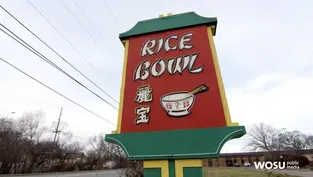Columbus Neighborhoods
Why is there no Chinatown in Columbus, Ohio?
Clip: Season 7 Episode 23 | 5m 45sVideo has Closed Captions
Unlike other major cities, Columbus does not have an area that reflects Asian heritage.
Columbus has well-known neighborhoods like Italian Village and German Village names that reflect European immigration to Central Ohio. But unlike other major cities, Columbus does not have a neighborhood that reflects Asian heritage. Curious Cbus received a submission from someone wanting to know “Why is there no Chinatown in Columbus, Ohio?”
Problems with Closed Captions? Closed Captioning Feedback
Problems with Closed Captions? Closed Captioning Feedback
Columbus Neighborhoods is a local public television program presented by WOSU
Columbus Neighborhoods
Why is there no Chinatown in Columbus, Ohio?
Clip: Season 7 Episode 23 | 5m 45sVideo has Closed Captions
Columbus has well-known neighborhoods like Italian Village and German Village names that reflect European immigration to Central Ohio. But unlike other major cities, Columbus does not have a neighborhood that reflects Asian heritage. Curious Cbus received a submission from someone wanting to know “Why is there no Chinatown in Columbus, Ohio?”
Problems with Closed Captions? Closed Captioning Feedback
How to Watch Columbus Neighborhoods
Columbus Neighborhoods is available to stream on pbs.org and the free PBS App, available on iPhone, Apple TV, Android TV, Android smartphones, Amazon Fire TV, Amazon Fire Tablet, Roku, Samsung Smart TV, and Vizio.
Providing Support for PBS.org
Learn Moreabout PBS online sponsorshipwosu's curious C bus answers your questions about our region its history and its people Columbus has well-known neighborhoods like Italian Village and German Village names that reflect European immigration to Central Ohio but unlike other major cities Columbus does not have a neighborhood that reflects Asian Heritage curious C bus received a submission from someone wanting to know why is there no Chinatown in Columbus Ohio to find an answer we spoke with history professor and author who Ping Ling well this is a great question but I think I want to maybe we have to clarify uh the definition of Chinatown generally when people talk about the Chinatown that means is several blocks of business and Commercial areas in the inner city where there's ethnic Chinese concentrated there are several elements right one is its location mostly the Chinatown is the inner city of the largest city and the second we can look at the demographic composition Chinatown along with Jewish town or Italian tongue or Japan usually the area where this ethnic group concentrated you can see the ethnic business and their lodging and often time if you see the front store then behind or upstairs where the family lives we can call it the historical Chinatown or conventional Chinatown or mainstream Chinatown which appeared in the United States as well as in Canada in Australia around 18 40s that's the time so-called Gold Rush appeared in those three localities so the Chinese are also migrated there and settled it down but since 1960s a dramatic political social historical and economic change happened we had this 1965 immigration reform that reformed the traditional quota system and allowed more professional and educated immigration to enter the country so that resulted a drastic change in the demographic picture of the ethnic Chinese communities foreign I have been studying uh Asian population Urban population since the 1980s but starting from the 1990s I began to focus down more in Midwest area okay in this locality because my job and of my research interests so the Midwest is unique the Asia American population for example Chicago Saint Louis Kansas City more than 60 percent of population were entrepreneurs and professions Warrior New York and San Francisco more than 80 percent of them were working class or small business shop owners or helpers so there's a big population compensation difference so that dictated that Asian Americans in Midwest a better integrated socially economically into large Society so that is a major difference and that difference determine them residentially more integrated into Suburban middle class neighborhood and there's no need to follow for them to form their concentrated a physical Chinatown another factor is the reception of the local area from both public and the government generally the public in the midwest is more laid back more friendly as early as the 1870s when Asian Americans first twist out of the West Coast by the anti-chinese sentiment and they deserved with words of cells and other area your life quality is better here you can live in a large more comfortable housing in suburban area so now the infrastructure is no longer those physical buildings the Chinatown you have the Chinese restaurants Chinese grocery stores or Chinese people live there so that kind of a physical infrastructure structure is replaced by this cultural okay Multicultural and the social infrastructure because America is a multi-ass new community it's a nation of the Nations so we'll still see the differences but they might not be in the traditional form of this physical ethnic concentrated areas foreign do you have a question for Curious seabus head to wosu.org curious to submit your idea vote on which question we should investigate next and see what we've covered so far
Asian Americans in Columbus Preview
Video has Closed Captions
Preview: S7 Ep23 | 30s | An exploration of the Asian American experience in Columbus, Ohio, over the last century. (30s)
Video has Closed Captions
Clip: S7 Ep23 | 8m 1s | The Rice Bowl has been on the South Side of Columbus since 1962. (8m 1s)
Providing Support for PBS.org
Learn Moreabout PBS online sponsorshipSupport for PBS provided by:
Columbus Neighborhoods is a local public television program presented by WOSU













